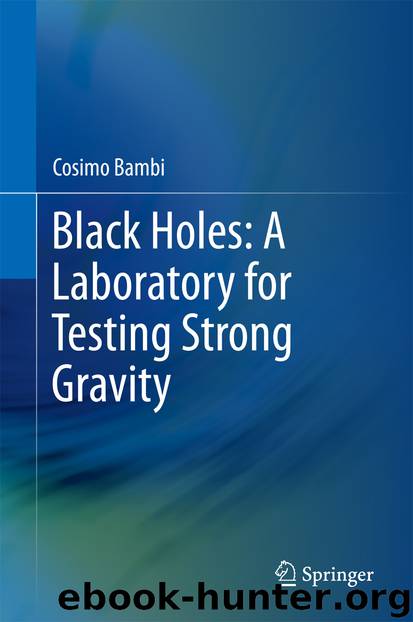Black Holes: A Laboratory for Testing Strong Gravity by Cosimo Bambi

Author:Cosimo Bambi
Language: eng
Format: epub
Publisher: Springer Singapore, Singapore
(8.3)
With the formalism of the transfer function, we can thus separate the calculations involving the astrophysical model (reflection spectrum) from those involving the relativistic effects on the photons (Doppler boosting, gravitational redshift, light bending). The function may depend on the background metric (see below the case of the lamppost set-up), but it is a minor job and the transfer function formalism is very convenient for the calculations.
While it is necessary to fit the full reflection spectrum to study a source and determine its parameters, in this section we will restrict the attention to the iron K line only. This will permit to better understand the impact of the strong gravity region on the shape of the reflection spectrum.
The shape of the line is primarily determined by the background metric, the geometry of the emitting region, the disk emissivity, and the disk’s inclination angle with respect to the line of sight of the distant observer. In the Kerr background, the relativistic emission line profile emitted by an accretion disk illuminated by an X-ray corona with arbitrary geometry is typically parametrized by the black hole spin , the inner and the outer edge of the emission region and , and the viewing angle i. The intensity profile may be modeled as a power-law , where the emissivity index q is a free parameter to be determined by the fit. A more sophisticated choice is to assume a broken power-law, i.e.
Download
This site does not store any files on its server. We only index and link to content provided by other sites. Please contact the content providers to delete copyright contents if any and email us, we'll remove relevant links or contents immediately.
Tools of Titans by Timothy Ferriss(7815)
Turbulence by E. J. Noyes(7702)
Astrophysics for People in a Hurry by Neil DeGrasse Tyson(5002)
Secrets of Antigravity Propulsion: Tesla, UFOs, and Classified Aerospace Technology by Ph.D. Paul A. Laviolette(4994)
Design of Trajectory Optimization Approach for Space Maneuver Vehicle Skip Entry Problems by Runqi Chai & Al Savvaris & Antonios Tsourdos & Senchun Chai(4843)
Room 212 by Kate Stewart(4739)
Pale Blue Dot by Carl Sagan(4618)
The David Icke Guide to the Global Conspiracy (and how to end it) by David Icke(4381)
A Journey Through Divination and Astronomy by Publishing Pottermore(4250)
Apollo 8 by Jeffrey Kluger(3512)
Goodbye Paradise(3446)
Losing the Nobel Prize by Brian Keating(3425)
COSMOS by Carl Sagan(3348)
The Five People You Meet in Heaven by Mitch Albom(3335)
How to Read Water: Clues and Patterns from Puddles to the Sea (Natural Navigation) by Tristan Gooley(3240)
Brief Answers to the Big Questions by Stephen Hawking(3239)
How to Read Nature by Tristan Gooley(3079)
The Order of Time by Carlo Rovelli(3073)
A Brief History of Time by Stephen Hawking(2819)
